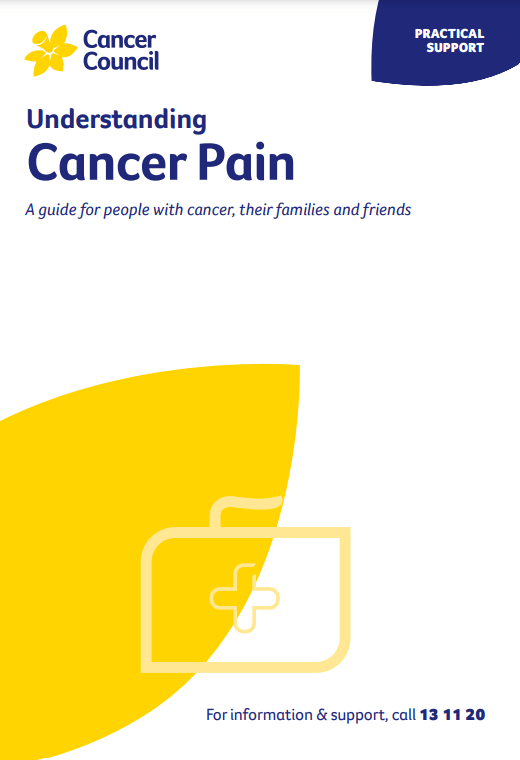- Home
- Cancer Information
- Managing side effects
- Pain and cancer
- Managing pain with other methods
- Medical procedures
Medical procedures for pain
Pain can sometimes be managed with other medical procedures. This can include simple options such as nerve blocks to more complex procedures such as implanted pumps. These options can be temporary or longer lasting. They are not suitable for everyone, but can be particularly useful for treating nerve pain or pain that has been difficult to control with other medicines. Ask your pain specialist to explain the risks and benefits of each procedure they recommend.
Learn more about:
- Nerve block
- Radiofrequency ablation (RFA)
- Epidural
- Spinal catheter with port or pump
- Spinal cord stimulator
Nerve block
A nerve block numbs the nerve sending pain signals to the brain. It is usually an injection of local anaesthetic, similar to when a dentist numbs a painful tooth. Sometimes an x-ray or ultrasound machine is used to help guide the needle. In most cases, the numbing effect lasts for a few hours but it sometimes lasts for days.
A nerve block is generally used to provide short-term pain relief or to help diagnose which nerve is sending the pain signals. This can be used to help with pain after an operation.
Radiofrequency ablation (RFA) or pulsed radiofrequency
This procedure can be used after some nerve blocks to provide longer-lasting pain relief.
There are different types of RFA:
- Pulsed RFA – applies electric pulses to change how the brain senses the pain signal.
- Thermal RFA – uses heat to damage the nerve and block it from sending pain signals to the brain.
Your treating pain specialist will let you know what type of radiofrequency is most suitable. Relief from RFA is instant for some people, but for others may take up to two months to work. It can last for nine months to more than two years.
Epidural
This is an injection of local anaesthetic and sometimes other pain medicines near the nerves in the back.
The pain relief can last for up to two weeks. An epidural can also be used to see if a spinal procedure (see below) is likely to help. It is sometimes offered to help with pain after an operation.
Spinal catheter with port or pump
If longer-term pain control is needed, a small tube (epidural catheter) may be placed a little deeper in the back. This is connected to an opening (port), which allows pain medicine to be dripped in continuously. If pain is likely to last longer than six months, the catheter is attached to a small pump under the skin of the abdomen (known as an intrathecal pump). This pump is refilled about every three months with pain medicine. The pump can be adjusted depending on how much pain relief you need.
I have an intrathecal pump, which is filled by a community nurse. I also take breakthrough medication, but some days I don’t need any. You can never tell. The pain is mysterious.
Katie
Spinal cord stimulator
This is a long-lasting procedure to treat nerve pain problems. A device is implanted into the spine, and a remote control is used to send low levels of electricity. It causes tingling against the nerves in the back or neck, which reduces the amount of pain felt. The procedure is done in two steps, with the first step as a trial to see if it provides relief. If pain relief is above 60%, the second step is to permanently implant the device.
Podcast: Managing Cancer Pain
Listen now
More resources
Dr Tim Hucker, Pain Medicine Specialist, Peter MacCallum Cancer Centre, VIC; Dr Keiron Bradley, Palliative Care Consultant, Bethesda Health Care, WA; A/Prof Anne Burke, Co-Director Psychology, Central Adelaide Local Health Network, President, Australian Pain Society, Statewide Chronic Pain Clinical Network, SA, School of Psychology, The University of Adelaide, SA; Tumelo Dube, Accredited Pain Physiotherapist, Michael J Cousins Pain Management and Research Centre, Royal North Shore Hospital, NSW; Prof Paul Glare, Chair in Pain Medicine, Palliative Medicine Specialist, Pain Management Research Institute, The University of Sydney, NSW; Andrew Greig, Consumer; Annette Lindley, Consumer; Prof Melanie Lovell, Palliative Care Specialist HammondCare, Sydney Medical School and The University of Technology Sydney, NSW; Caitriona Nienaber, 13 11 20 Consultant, Cancer Council WA; Melanie Proper, Pain Management Specialist Nurse Practitioner, Royal Brisbane and Women’s Hospital, QLD; Dr Alison White, Palliative Medicine Specialist and Director of Hospice and Palliative Care Services, St John of God Health Care, WA.
View the Cancer Council NSW editorial policy.
View all publications or call 13 11 20 for free printed copies.
Need to talk?
Support services
Coping with cancer?
Speak to a health professional or to someone who has been there, or find a support group or forum
Need legal and financial assistance?
Pro bono services, financial and legal assistance, and no interest loans
Cancer information
Dealing with the diagnosis
Common reactions to a cancer diagnosis and how to find hope
View our publications
Guides and fact sheets for people with cancer, their families and friends


